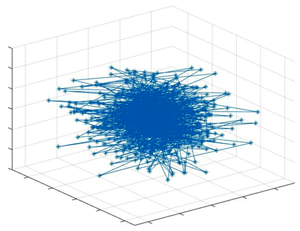Nonparametric method of Doppler frequency estimation taking into account deformation of envelope and center frequency shift of signal distorted by multiplicative interference
DOI:
https://doi.org/10.3103/S0735272723090017Keywords:
BDS statistics, Cauchy distribution, BPSK signal, multiplicative interference, estimation of parametersAbstract
The paper considers a nonparametric method for estimating the Doppler frequency of a broadband signal with code (digital) phase manipulation distorted by multiplicative interference. The estimation of the Doppler frequency, which leads to the deformation of the envelope and shift of carrier frequency, was carried out in the absence of a priori information about the probability density function of the noise component in the model of the received signal (observation). An assumption is made that the noise component is an independent and identically distributed (IID) process with independent and identically distributed random quantities (“white” noise). The objective function (OF) is proposed that uses BDS statistics of discrepancies, i.e., the difference between an observation and the expected signal model, to estimate the Doppler frequency. The OF minimum is adopted as an estimate of the parameter. Quality characteristics of the Doppler frequency estimation are investigated in the case of additive noise when observing a signal with different probability distributions: Gaussian, uniform, logistic, and Cauchy. Special attention is paid to the case when the probability density function of multiplicative interference is characterized by “heavy tails.” The statistical modeling of the Doppler frequency estimation algorithm that implements the numerical minimization of the proposed objective function has been carried out. It is shown that the use of BDS statistics and the proposed objective function based on it allows us to avoid specifying the distribution density of the multiplicative interference when determining the Doppler frequency.
References
- P. Y. Kostenko, S. Y. Falkovich, Foundations of Statistical Theory of Information-Measuring Radio-Engineering Systems. Kharkiv: KhNUPS, 2021.
- А. A. Golikov, A. A. Makarov, A. V. Salnikova, D. N. Shepelev, “Estimation of arrival time of radio signal with envelope of arbitrary shape and unknown center frequency in presence of modulating interference,” Vestn. Vor. State Univ. Ser. Physics. Math., no. 4, pp. 5–17, 2020, doi: https://doi.org/10.5281/zenodo.4455949.
- A. P. Trifonov, Y. E. Korchagin, S. V. Korol’kov, “Estimation of the arrival time and duration of a radio signal with unknown amplitude and initial phase,” Radiophys. Quantum Electron., vol. 60, no. 11, pp. 920–930, 2018, doi: https://doi.org/10.1007/s11141-018-9858-7.
- A. P. Trifonov, A. V. Zakharov, A. M. Vorobiev, “Asymptotic characteristics of joint estimates of signal parameters,” Vestn. Vor. State Univ. Ser. Physics. Math., no. 2, pp. 77–92, 2003.
- P. Y. Kostenko, V. V. Slobodyanuk, H. Y. Dukin, “Comparative analysis of resolution of nonparametric BDS criterion and maximum likelihood criterion for estimation of delay and Doppler frequency shift of pulse signal,” Radioelectron. Commun. Syst., vol. 65, no. 10, pp. 517–531, 2022, doi: https://doi.org/10.3103/S0735272722120081.
- P. Y. Kostenko, K. S. Vasiuta, “The use of BDS statistics for estimating the parameters of chaotic mappings and regular signals in the presence of noise,” Radioelectron. Commun. Syst., vol. 54, no. 3, pp. 155–162, 2011, doi: https://doi.org/10.3103/S073527271103006X.
- V. Slobodyanuk, “Nonparametric method for estimating the Doppler frequency of a wideband signal distorted by additive noise with unknown probability distribution density,” Inf. Process. Syst., no. 4 (171), pp. 62–75, 2022, doi: https://doi.org/10.30748/soi.2022.171.07.
- J. P. Theiler, “Quantifying chaos: practical estimation of the correlation dimension,” 1988. doi: https://doi.org/10.7907/ct5h-nx62.
- A. S. Weigend, Time Series Prediction. New York: Routledge, 2018, doi: https://doi.org/10.4324/9780429492648.
- W. D. Dechert, “The correlation integral and the independence of stochastic processes,” 2005. uri: https://ideas.repec.org/p/att/wimass/200517.html.
- E. I. Dronkin, O. D. Mrachkovsky, “Wide-band ambiguity function of finite volume,” Radioelectron. Commun. Syst., vol. 53, no. 2, pp. 95–105, 2010, doi: https://doi.org/10.3103/S0735272710020044.
- Z. Lin, “Wideband ambiguity function of broadband signals,” J. Acoust. Soc. Am., vol. 83, no. 6, pp. 2108–2116, 1988, doi: https://doi.org/10.1121/1.396391.
- C. S. Pappu, A. N. Beal, B. C. Flores, “Chaos based frequency modulation for joint monostatic and bistatic radar-communication systems,” Remote Sens., vol. 13, no. 20, p. 4113, 2021, doi: https://doi.org/10.3390/rs13204113.
- J. Jiang et al., “An efficient algorithm for WBAF estimation based on linear interpolation and its estimation error,” Appl. Acoust., vol. 142, pp. 44–52, 2018, doi: https://doi.org/10.1016/j.apacoust.2018.08.001.
- L. Li, N. H. Younan, X. Shi, “Parameter estimation based on sigmoid transform in wideband bistatic MIMO radar system under impulsive noise environment,” Sensors, vol. 19, no. 2, p. 232, 2019, doi: https://doi.org/10.3390/s19020232.
- K. V. Mishra, S. Pinilla, A. Pezeshki, A. R. Calderbank, “Group-theoretic wideband radar waveform design,” in 2022 IEEE International Symposium on Information Theory (ISIT), 2022, pp. 1821–1825, doi: https://doi.org/10.1109/ISIT50566.2022.9834664.
- L. Kanzler, “Very fast and correctly sized estimation of the BDS statistic,” SSRN Electron. J., 1999, doi: https://doi.org/10.2139/ssrn.151669.
- W. A. Broock, J. A. Scheinkman, W. D. Dechert, B. LeBaron, “A test for independence based on the correlation dimension,” Econom. Rev., vol. 15, no. 3, pp. 197–235, 1996, doi: https://doi.org/10.1080/07474939608800353.
- V. M. Galkin, L. N. Erofeeva, S. V. Leshcheva, “Estimates of Cauchy distribution parameter,” Tr. NGTU named after R. E. Alekseev, no. 2 (104), pp. 314–319, 2014.
- S. S. Akimov, V. A. Tripkosh, “Comparison of some methods for assessing the weight of tails in identification of the distribution law,” Mod. High Technol., no. 2, pp. 9–13, 2021, doi: https://doi.org/10.17513/snt.38486.


